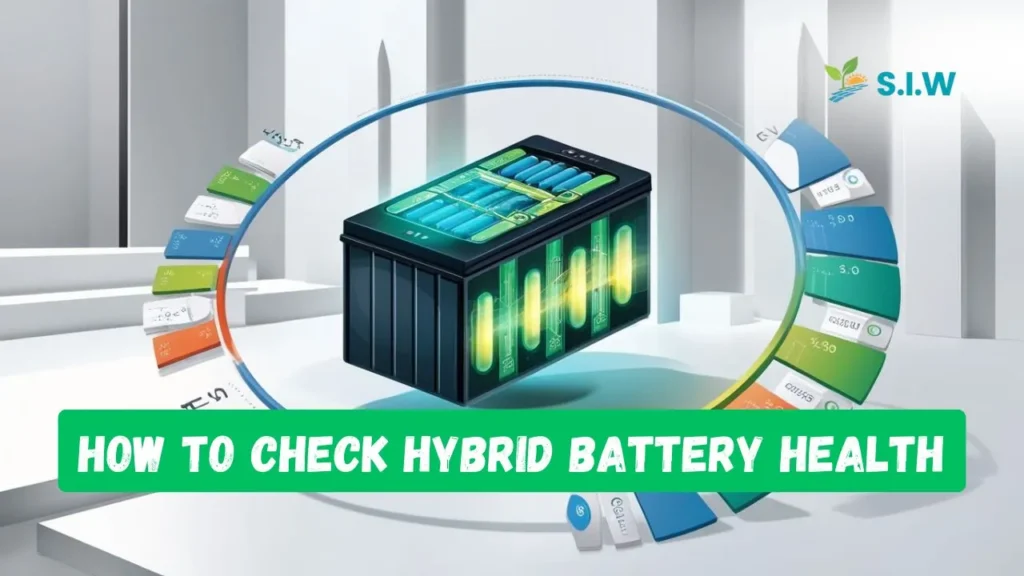Maintaining your hybrid vehicle’s battery is crucial for its long-term performance and cost-efficiency. Hybrid batteries are designed to last for many years, but over time, their efficiency may decrease. Knowing how to check the health of your hybrid battery can save you from unexpected breakdowns and ensure that your car performs optimally. In this guide, we will walk you through various methods to evaluate your hybrid battery’s health.
What is a Hybrid Battery?
Hybrid batteries are a combination of electric and chemical energy storage systems, providing power to the electric motor in hybrid vehicles. These batteries are often made of either Nickel-Metal Hydride (NiMH) or Lithium-ion (Li-ion) batteries, both of which offer long-lasting performance. However, like any battery, they degrade over time due to repeated charging and discharging cycles.
Why is Hybrid Battery Health Important?
A deteriorating hybrid battery can lead to reduced fuel efficiency, lower performance, and increased emissions. In the worst-case scenario, replacing a hybrid battery can be expensive, which is why regular health checks are essential. Monitoring your battery’s health allows you to predict when a replacement might be necessary and maintain your car’s overall performance. Similarly, hybrid solar systems also require regular maintenance and monitoring to ensure optimal efficiency and longevity. Keeping an eye on both your vehicle’s hybrid battery and your hybrid solar systems can help you avoid costly replacements and maximize performance.
Methods to Check Hybrid Battery Health
1. Onboard Diagnostics (OBD-II Scanner)
One of the most effective ways to check your hybrid battery health is by using an Onboard Diagnostic Scanner (OBD-II). Most hybrid vehicles have an OBD-II port that allows you to connect a diagnostic tool to read and analyze the health of your battery.
- Steps to Follow:
- Purchase an OBD-II scanner compatible with hybrid vehicles.
- Plug the scanner into your vehicle’s OBD-II port (usually located under the dashboard).
- Follow the prompts on the scanner to retrieve battery health information.
- Look for key metrics such as battery voltage, state of charge (SoC), and state of health (SoH).
- Advantages: This method provides real-time data, making it a reliable way to assess battery condition. Additionally, it can detect error codes that indicate deeper issues with the battery system.
2. Built-in Vehicle Diagnostics
Many modern hybrid vehicles come equipped with built-in diagnostic systems that provide information about the health of the battery. This can be accessed through the vehicle’s infotainment system or dashboard display.
- Steps to Follow:
- Navigate to the vehicle’s settings menu.
- Look for options related to energy consumption or battery health.
- View the displayed battery metrics, which may include charge levels and estimated remaining lifespan.
- Advantages: This method is simple, requiring no additional equipment. However, the accuracy may not be as high as using an OBD-II scanner.
3. Battery Test at a Service Center
If you’re unsure of your ability to test the battery yourself, or if the diagnostics tools aren’t providing sufficient detail, visiting a service center is a reliable option. Hybrid specialists can perform a detailed health check of the battery, often providing a more comprehensive analysis than DIY methods.
- What to Expect:
- The service center will connect professional diagnostic equipment to your car.
- They will measure specific metrics such as internal resistance, battery temperature, and capacity.
- The results will give you a clearer picture of your battery’s overall condition and how much life it has left.
- Advantages: This option provides the most accurate results, and technicians can advise on whether the battery requires maintenance or replacement.
4. Hybrid Battery Monitoring Apps
There are several mobile apps designed to monitor hybrid battery health. These apps work in conjunction with OBD-II scanners and can display more detailed data directly on your phone.
- Recommended Apps:
- Torque Pro
- Hybrid Assistant
- Dr. Prius (specific to Toyota Prius models)
- How to Use:
- Download one of the recommended apps.
- Connect your OBD-II scanner to your phone via Bluetooth.
- Open the app and follow the prompts to check battery health.
- Advantages: Apps often provide more user-friendly interfaces, making it easier to understand the battery’s status. They may also offer additional features such as performance graphs and alerts.
Key Metrics to Watch
1. State of Charge (SoC)
SoC refers to the amount of charge the battery currently holds relative to its full capacity. Maintaining an optimal SoC is critical for extending the battery’s lifespan.
2. State of Health (SoH)
SoH provides an estimate of the battery’s overall condition, comparing its current capacity to its original capacity when it was new. A significant decrease in SoH indicates that the battery is nearing the end of its useful life.
3. Voltage Levels
Monitoring voltage levels across the individual cells of the battery can help identify any imbalances. If some cells have much lower voltage than others, it may indicate that the battery is starting to fail.
4. Internal Resistance
Higher internal resistance indicates that the battery is degrading, as it has to work harder to deliver power. This can lead to decreased performance and fuel efficiency.
Best Practices for Maintaining Hybrid Battery Health
- Regular Driving: Hybrid batteries degrade faster when they are not used regularly. Driving your vehicle frequently helps maintain battery health.
- Avoid Extreme Temperatures: High or low temperatures can affect the battery’s performance. Where possible, park in a shaded or covered area to protect the battery from extreme heat.
- Regular Servicing: Scheduled maintenance at a certified service center can help identify issues early, preventing more serious problems down the road.
Checking and maintaining your hybrid battery’s health is essential for ensuring the longevity and performance of your vehicle. With various methods such as using OBD-II scanners, built-in diagnostics, or visiting a service center, you can stay informed about the condition of your battery. By taking proactive steps, you can extend the life of your hybrid battery, avoid costly replacements, and keep your vehicle running smoothly.








